Undersea Slide May Have Triggered Deadly Tsunami
- Share via
A five-member scientific team that visited the site of the July 17 tsunami on the Papua New Guinea coast now theorizes that the deadly sea waves were probably the result of an undersea landslide caused by an earthquake centered inland.
This is a different scenario than the one reported in some initial dispatches from the site of the South Pacific disaster, which said the tsunami was set off by a magnitude 7.0 earthquake centered 12 miles out to sea.
The death toll exceeds 3,000, including hundreds of people whose bodies have not been recovered, making it probably the deadliest tsunami of the 20th century.
The scientific team, whose trip was funded by the National Science Foundation, was headed by USC civil engineering professor Costas Synolakis and spent several days examining the area.
“We used to think a magnitude 7.0 earthquake was too small to generate a tsunami,” Synolakis said in a written report. “Of the nine large tsunamis that have occurred in the past six years, only the New Guinea one resulted from an earthquake as small.”
But Synolakis and associate Emile Okal, a geophysics professor from Northwestern University, are confident that a landslide caused the displacement of water resulting in the tsunami, citing three reasons.
“One, we can’t explain the size of the tsunami otherwise,” Okal said. “Two, we know sub-marine landslides have occurred in other areas, since they’re conspicuous on the ocean floor in other subduction zones [similar to this one].
“And, three, we found a landslide above sea level while we were there. A cliff at the western end of our land survey area showed a big landslide that was extremely fresh. People told us it went down during the earthquake.”
Okal conceded, “It’s a big jump to the conclusion that the same thing happened below the sea. But certainly, in terms of the accelerations and the intensity of motion, what took place under the water was probably the same as what took place next door, above the water, and if the material had the same level of instability, one could imagine a sub-marine landslide.”
The scientists suggested the use of sonar by an oceanographic ship to look for evidence of the landslide.
The scientists also noted that the topography on the New Guinea coast--where the ocean floor drops rapidly close to shore--is similar to that found in coastal areas throughout the world, including Southern California.
It thus is conceivable that a similar tsunami could strike the Los Angeles-Orange County metropolitan area, they said. Although no such huge wave has been reported in Southern California, small tsunami surges have come to shore.
The scientists said their examination of the New Guinea tsunami area and interviews with local residents indicated that three separate waves, initially no more than 10 feet, gained height as they raced toward the coast.
“On touching land, the largest waves were 32 to 46 feet high at the center,” Synolakis said, “and about 12 miles long, with the maximum height of the waves falling off significantly a short distance from each wave’s center.
The mass of water in each wave extended back from the crest about 2 1/2 miles, he said.
“The water surged over the affected peninsula at an estimated speed of 22 to 44 mph,” the USC professor said, noting that the force induced by a tsunami current is 1,000 times greater than that of a wind gust of the same speed.
The team visited the area in the first week of August, about two weeks after the tsunami struck.
The investigators said that in their meetings with survivors they tried to quash wild rumors about the diaster’s cause. Many survivors believed that they were being punished for impiety and that more waves were imminent.
Witnesses described the tsunami as “an infernal mountain of water with fire sparkles flying,” and believed those had caused the severe burns observed among many of the dead.
But the burns actually resulted from friction when the victims were dragged over long distances of sand, debris and trees, and from sunburn as they lay decomposing after the disaster, the scientists reported.
Glowing organisms frequently found in the South Pacific enhanced the impression that the waves carried fire within them, the scientists said.
“The tsunami occurred about an hour after sundown,” Synolakis explained. “In the darkness, the organic bioluminescence may well have caused the water to sparkle like fire.”
More to Read
Sign up for Essential California
The most important California stories and recommendations in your inbox every morning.
You may occasionally receive promotional content from the Los Angeles Times.













